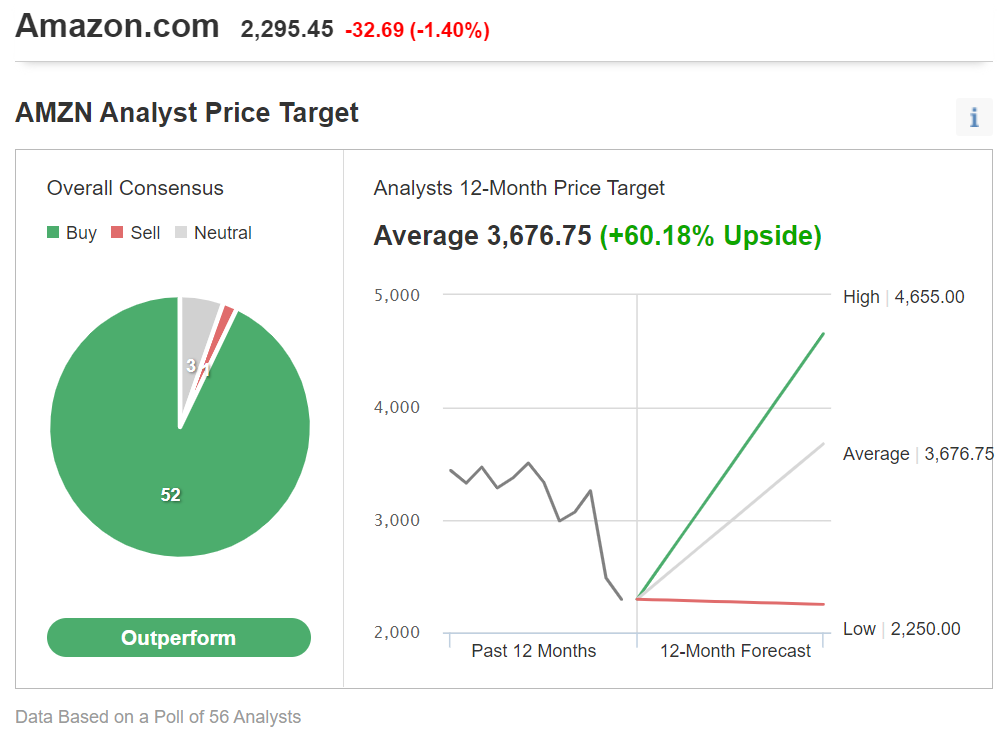- Amazon Q1 sales rose just 7% compared with 44% expansion in the year-ago period
- Despite the setback on the earnings front, the majority of Wall Street analysts remain bullish on the company’s long-term prospects
- Bank of America sees a “significant” expansion in profit margins from 2023 to 2025
- For tools, data, and content to help you make better investing decisions, try InvestingPro+
E-commerce, which till now has been one of the safest areas of the digital economy, is starting to show signs of weakness after two years of remarkable gains.

Revenue at the world’s largest online retailer, Amazon.com (NASDAQ:AMZN), rose just 7% during the first quarter of 2022, compared to the 44% expansion during the year-ago period. It marked the slowest rate of growth for the Seattle-based company for any quarter since the dot-com bust in 2001 and the second straight period of single-digit growth.
A week later, the latest earnings of Ottawa-based Shopify (NYSE:SHOP) also disappointed investors. The merchant-focused platform reported per share profit was far less than what analysts had expected. The company also provided a weaker outlook for adding new business customers in 2022, saying growth in vendors on its platform would be “comparable” to 2021.
These dismal earnings reports triggered a massive sell-off of these and other e-commerce stocks, suggesting that investors don’t see a rebound in the segment anytime soon.
Since the company reported earnings on Apr. 28, Amazon shares have tumbled more than 14%. They closed on Friday at $2295.45, the weakest level for the stock in about two years. Shares are down more than 30% in 2022.
The powerful rally in e-commerce stocks seen at the height of COVID-19 lockdowns in 2020 is winding down quickly as these online retailers navigate a host of challenges, including inflation that’s running near a four-decade high, surging labor costs, global supply chain bottlenecks, and the ongoing pandemic.
No Quick Turnaround
To offset some of those losses, Amazon earlier this month introduced a 5% surcharge for some of its US sellers, the first such fee in the company's history. And last quarter, Amazon hiked the price of its US Prime membership for the first time in four years to $139 from $119.
Despite these measures, Amazon management doesn’t see a quick turnaround. CEO Andy Jassy said in a statement during the last earnings report:
“This may take some time, particularly as we work through ongoing inflationary and supply chain pressures, but we see encouraging progress on a number of customer experience dimensions, including delivery speed performance as we’re now approaching levels not seen since the months immediately preceding the pandemic in early 2020.”
Despite the setback on the earnings front, the majority of Wall Street analysts remain bullish on the company’s long-term prospects and its leading position in e-commerce. Though some have adjusted their price targets on the stock as sales slow, many believe any lingering weakness offers a buying opportunity.
Of 56 analysts polled by Investing.com, 52 had a buy rating on AMZN, labeling it a stock that will 'outperform.'

Source: Investing.com
Among those surveyed, the average 12-month price target was $3,676.75, for a 60.18% upside on shares.
One area in which the company continues to impress is its Amazon Web Services division, the company's cloud unit. It currently generates most of the company’s profit. AWS reported a 37% increase in revenue to $18.4 billion. Indeed, the tally of commitments that customers have made to future AWS purchases surged 68% from the prior year, to $88.9 billion.
Bank of America, while reducing its price target from $4,225 to $3,770 in a post-earnings note, said that cost pressures should be “manageable,” and that Amazon will see a “significant” expansion in profit margins from 2023 to 2025 coming from its cloud, advertising, and third-party marketplace.
Cowen & Co. analysts believe Amazon has plenty of pricing power when it comes to Prime. It noted that a further hike in the membership fee could offset AMZN losses in the e-commerce segment.
Bottom Line
Amazon will struggle to expand its e-commerce business in the current inflationary environment, creating significant headwinds for the company’s stock price in the short run. That said, analysts are almost unanimous in their views that the company’s dominant position in many areas of the digital economy is not under threat and investors should take this weak spell as a buying opportunity.
Interested in finding your next great investing idea? InvestingPro+ gives you the chance to screen through 135K+ stocks to find the fastest growing or most undervalued stocks in the world, with professional data, tools, and insights. Learn More »
